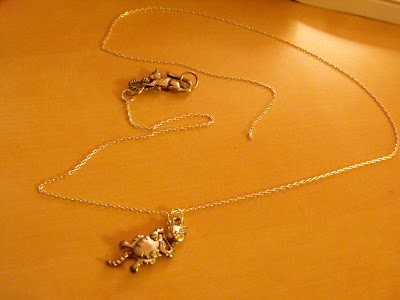Here are the directions for a simple charm and chain necklace I made for my fantastic sister.
Materials
- Silver chain. I like my necklaces pretty long, but usually necklaces are either about 18" long or 22" long. The length of the chain for this necklace is about 24 inches. Michael's Arts and Crafts sells really inexpensive jewelry making supplies, like their small cable chains. You will need jewelry metal clippers (I am not sure of the technical term, sorry) to cut the desired length.
- One cat charm (this one has moving parts--the head moves a bit)
- One clasp. For this necklace, I found an awesome cat "s" clasp.
- Three 6mm round jump rings
 |
| The split in the center allows you to use the jump ring to attach and connect items |
- You will also need some needle nose pliers and clippers for cutting the chain.
- *Note on Materials* Make sure all metal materials are made from the same metal (i.e. gold, gold fill, silver plating, pewter, etc...also, gold plated fixings are not as expensive as one would expect, Michael's arts and crafts prices them at the same price of silver, although the selection is not as expansive). This ensures that is the necklace ages and if it tarnishes the color will be consistent throughout the piece.
 |
| Note how all of the materials match. |
Steps:
1. Cut chain to length desired
2. Fix one jump ring to charm by....
 |
| Bend open jump ring enough to allow charm to slide on to ring with pliers. Be careful not to open it too wide or else the ring might become a little crooked |
 |
| Now, carefully close the jump ring in the same manner as you opened the jump ring. |
 |
| Here is what the charm should look like once you have affixed the jump ring properly. |
3. Now you will attach one jump ring to the chain. Follow the directions given in the picture captions below. (I used a finer chain, so if your jump ring can fit into the last link, you can skip this how to widen the link to affix the jump ring to the smaller chain...go down to the step where you affix the chain to the cat clasp using the jump ring)
 |
| Gently use the needle nose pliers, put enough pressure on the handles to round out the link so the jump ring can be used. |
 |
| This is what it should look like once you have rounded the link (and before the jump ring) |
 |
| Open one of the jump rings in the same manner mentioned above, and slide it into the newly rounded link. Do not close it yet, as the clasp needs to be added. |
 |
| Once you slide the ring that is already affixed to the clasp, bend the jump ring closed. |
4. At this point, only one end should be attached to the clasp. Now, slide the cat charm via the jump ring onto the chain by the end that does not have a jump ring attached.
5. Now, round out the last link on the other end of the chain (make sure the chain is not twisted), attach jump ring, affix to clasp. Voila! You are done!
 |
| The necklace in its entirety. It's simple, yet unique. |
 |
| A close up of the necklace. An easy was to give a necklace as a gift and to prevent tangles is to cut into an index card and tape the chain to the back. |









































